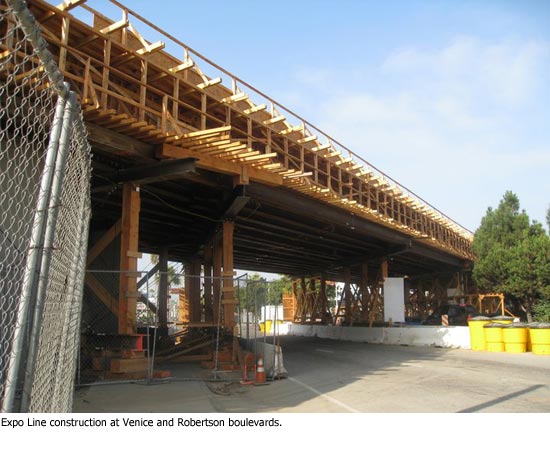Judge rejects Expo Line challenge
February 24, 2011
In a significant victory for the Expo Line light rail project, a Superior Court judge has turned away a legal challenge that could have delayed or permanently derailed the line’s final leg to Santa Monica.
Judge Thomas I. McKnew, Jr., ruling in a case brought by the group Neighbors for Smart Rail, found that the environmental impact review for the Expo Line’s second phase was sound.
“EXPO carefully made its decision concerning the project with its environmental consequences in mind,” McKnew said in his ruling, which was faxed to attorneys in the case Tuesday.
There is no evidence, the judge found, to support the neighborhood group’s claim that Expo manipulated the alternatives “so that the project would appear to be better from a cost and environmental standpoint than the other choices.”
Supervisor Zev Yaroslavsky, a strong supporter of the project and a member of the Expo construction authority’s board of directors, which approved Phase 2 of the project last year, called the decision “a major milestone on the road to finishing the second phase of the Expo light rail project from Culver City to Santa Monica.”
“The court’s ruling is thoughtful and thorough and validates the difficult and meticulous work that the Expo Light Rail Authority, its staff and consultants did to ensure that this project will be safe, environmentally sound and sensitive to the communities through which it will travel,” Yaroslavsky said.
When completed, the 15.2 mile line will provide access to many cultural and community venues in downtown and beyond, including USC and the beach. It is expected to carry 64,000 passengers a day, making it one of the most heavily used rail lines in the country, Expo officials said.
Proponents of the Expo Line, which is being financed largely with revenues from the voter-approved Measure R, note also that it will be a key conduit for workers commuting to the jobs-rich Westside.
Opponents in the Neighbors for Smart Rail group, which includes a number of local homeowners associations, say they are not against a rail system as such, but contend it should run underground for safety and quality of life reasons.
But the judge found that Expo officials had fully explored the alternatives to running at street level and were correct in rejecting those approaches. Going underground could have caused “disruption of gravity fed storm drains, potential flooding of underground stations, increased construction impacts…and finally considerable increase in costs ($224.3 million.)”
The judge added that an aerial structure design “would result in creating a large physical barrier bisecting the neighborhood, create construction impacts similar to the trench option and increase costs ($65.9 million) without significant reduction of other impacts.”
The project approach that was ultimately selected is better than the alternatives from environmental, efficiency and cost standpoints, the judge found.
“We will finally have an alternative to the awful traffic, and hopefully no more delays,” said Darrell Clarke, co-chair of Friends 4 Expo Transit, which supports the Phase 2 plan. “I’ve only been an advocate for this thing for 21 years.”
However, Neighbors for Smart Rail announced it would appeal the ruling and is “confident that the appellate court will review the plain facts of the case and find that the Expo environmental review was fatally flawed and must be corrected.”
The organization said in a statement that it “remains dedicated to making sure that key north/south streets such as Overland and Sepulveda are not blocked 24 times per hour, that West L.A. traffic is not edged closer to gridlock by an ill-conceived light rail plan, that children are not put at risk by trains running just feet from their schools and that first responders will not be hampered by blocked arterials in their efforts to save lives and property.”
The $930 million first phase of the project, running parallel to the heavily congested 10 Freeway from downtown to Culver City, is scheduled to be completed in early 2012. (An opening of some of the line will take place later this year.) The $1.5 billion second phase, to extend the line to Colorado and 4th Street in Santa Monica by 2015, is expected to begin some construction later this year, after a contract is awarded to build it in coming weeks.
Posted 2/23/11













 405 bridge work causes a stink
405 bridge work causes a stink

